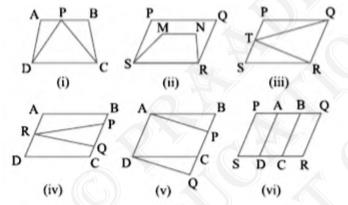Exercise 9.1 class 9 || class 9 Areas of Parallelograms and Triangles exercise 9.1 || exercise 9.1 class 9 maths || class 9 exercise 9.1 || ncert solutions for class 9 chapter Areas of Parallelograms and Triangles exercise 9.1 || Areas of Parallelograms and Triangles class 9 exercise 9.1 || exercise 9.1 class 9 solutions || class 9 maths chapter 9 exercise 9.1
Explore clear, step-by-step solutions for Class 9 Maths Chapter 9, Exercise 9.1, which introduces students to the fundamental concepts related to the areas of parallelograms and triangles. This exercise helps learners understand how geometric properties like base and height contribute to calculating area and how figures with the same base and height can have equal areas. By applying these concepts, students develop the ability to compare and analyze different shapes using mathematical reasoning. The problems are designed to reinforce visual understanding, logical interpretation, and step-by-step proof-writing. Exercise 9.1 builds a strong foundation for advanced topics such as mensuration, coordinate geometry and practical applications of geometry in real life, encouraging both accuracy and conceptual clarity.

exercise 9.1 class 9 || class 9 Areas of Parallelograms and Triangles exercise 9.1 || exercise 9.1 class 9 maths || class 9 exercise 9.1 || ncert solutions for class 9 chapter Areas of Parallelograms and Triangles exercise 9.1 || Areas of Parallelograms and Triangles class 9 exercise 9.1 || exercise 9.1 class 9 solutions || class 9 maths chapter 9 exercise 9.1
Exercise 9.1

(ii) No, it can be observed that parallelogram \(PQRS\) and trapezium \(MNRS\) have a common base RS. However, their vertices, (i.e., opposite to the common base) \( \mathrm{P}, \mathrm{Q} \) of parallelogram and \( \mathrm{M}, \mathrm{N} \) of trapezium, are not lying on the same line
(iii) Yes, It can be observed that parallelogram \( P Q R S \) and triangle \( T Q R \) have a common base \( Q R \) and they are lying between the same parallel lines \(PS\) and \(QR\)
(iv) No, It can be observed that parallelogram \( A B C D \) and triangle \( P Q R \) are lying between same parallel lines \(AD\) and \(BC \). However, these do not have any common base
(v) Yes, It can be observed that parallelogram \(ABCD\) and parallelogram \( A P Q D \) have a common base \( A D \) and these are lying between the same parallel lines \(AD\) and \(BQ\)
(vi) No, It can be observed that parallelogram \(PBCS\) and \(PQRS\) are lying on the same base \(PS\). However, these do not lie between the same parallel lines.

